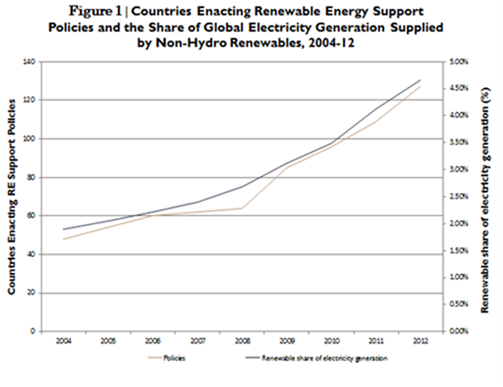 Policy Support for Renewable Energy Continues to Grow and EvolveWorldwatch Institute -- Vital Signs Online - Trend Release August 22, 2013
The majority of renewable energy support policies worldwide support electricity generation. Regulatory policies such as feed-in tariffs (FIT), net metering/billing, and renewable portfolio standards (RPS) or quotas have been developed to encourage the introduction of renewable energy technologies in the power sector. The adoption of new policies has been matched by an increasing share of non-hydro renewable energy in the global electricity mix. Feed-in tariffs, under which a renewable generator receives a fixed payment over a set time period for electricity generated and fed into the grid, remain the most widely enacted form of policy support. The United States is credited with developing the precursor to the feed-in tariff, in the Public Utility Regulatory Policies Act of 1978. The first modern FIT was enacted in Germany in 1990, and by 2000 feed-in policies had been adopted by 14 countries. Throughout the first decade of this century, the policy quickly gained momentum and became a primary tool for promoting renewable energy. An additional 54 countries enacted a FIT between 2000 and 2013. Including state and provincial policies in Australia, Canada, India, and the United States, 99 FIT policies are now in place worldwide at the national or state/provincial level. Municipal governments are also becoming more active in introducing FITs in cities. |
 Throughout much of the world, government support remains
essential for the growth of the renewable energy sector.
Support policies for renewable energy technologies
have increased dramatically over the last decade.
Historically, policy design has evolved from an initial
focus on supporting research and development in the
1970s and 1980s to today's focus on technology deployment
and market development. Starting in the mid-2000s,
deployment-focused policies have been enacted at
a rapid pace, growing from 48 countries with policies
in place by mid-2005 to a total of 127 countries as
of early 2013. (See Figure 1.) This expansion
has occurred across geographic and economic boundaries.
Developing and emerging economies accounted for less
than a third of all nations with policy support for
renewable energy in 2005, but by 2013 they accounted
for more than two thirds.
Throughout much of the world, government support remains
essential for the growth of the renewable energy sector.
Support policies for renewable energy technologies
have increased dramatically over the last decade.
Historically, policy design has evolved from an initial
focus on supporting research and development in the
1970s and 1980s to today's focus on technology deployment
and market development. Starting in the mid-2000s,
deployment-focused policies have been enacted at
a rapid pace, growing from 48 countries with policies
in place by mid-2005 to a total of 127 countries as
of early 2013. (See Figure 1.) This expansion
has occurred across geographic and economic boundaries.
Developing and emerging economies accounted for less
than a third of all nations with policy support for
renewable energy in 2005, but by 2013 they accounted
for more than two thirds.